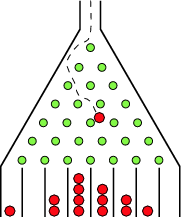

تاريخ الرياضيات

الاعداد و نظريتها

تاريخ التحليل

تار يخ الجبر

الهندسة و التبلوجي


الرياضيات في الحضارات المختلفة

العربية

اليونانية

البابلية

الصينية

المايا

المصرية

الهندية


الرياضيات المتقطعة

المنطق

اسس الرياضيات

فلسفة الرياضيات

مواضيع عامة في المنطق


الجبر

الجبر الخطي

الجبر المجرد

الجبر البولياني

مواضيع عامة في الجبر

الضبابية

نظرية المجموعات

نظرية الزمر

نظرية الحلقات والحقول

نظرية الاعداد

نظرية الفئات

حساب المتجهات

المتتاليات-المتسلسلات

المصفوفات و نظريتها

المثلثات


الهندسة

الهندسة المستوية

الهندسة غير المستوية

مواضيع عامة في الهندسة

التفاضل و التكامل


المعادلات التفاضلية و التكاملية

معادلات تفاضلية

معادلات تكاملية

مواضيع عامة في المعادلات


التحليل

التحليل العددي

التحليل العقدي

التحليل الدالي

مواضيع عامة في التحليل

التحليل الحقيقي

التبلوجيا

نظرية الالعاب

الاحتمالات و الاحصاء

نظرية التحكم

بحوث العمليات

نظرية الكم

الشفرات

الرياضيات التطبيقية

نظريات ومبرهنات


علماء الرياضيات

500AD

500-1499

1000to1499

1500to1599

1600to1649

1650to1699

1700to1749

1750to1779

1780to1799

1800to1819

1820to1829

1830to1839

1840to1849

1850to1859

1860to1864

1865to1869

1870to1874

1875to1879

1880to1884

1885to1889

1890to1894

1895to1899

1900to1904

1905to1909

1910to1914

1915to1919

1920to1924

1925to1929

1930to1939

1940to the present

علماء الرياضيات

الرياضيات في العلوم الاخرى

بحوث و اطاريح جامعية

هل تعلم

طرائق التدريس

الرياضيات العامة

نظرية البيان
Galton Board
المؤلف:
Chepelianskii, A. D. and Shepelyansky, D. L
المصدر:
Phys. Rev. Lett. 87
الجزء والصفحة:
...
17-10-2021
3035
Galton Board

The Galton board, also known as a quincunx or bean machine, is a device for statistical experiments named after English scientist Sir Francis Galton. It consists of an upright board with evenly spaced nails (or pegs) driven into its upper half, where the nails are arranged in staggered order, and a lower half divided into a number of evenly-spaced rectangular slots. The front of the device is covered with a glass cover to allow viewing of both nails and slots. In the middle of the upper edge, there is a funnel into which balls can be poured, where the diameter of the balls must be much smaller than the distance between the nails. The funnel is located precisely above the central nail of the second row so that each ball, if perfectly centered, would fall vertically and directly onto the uppermost point of this nail's surface (Kozlov and Mitrofanova 2002). The figure above shows a variant of the board in which only the nails that can potentially be hit by a ball dropped from the funnel are included, leading to a triangular array instead of a rectangular one.
Each time a ball hits one of the nails, it can bounce right (or left) with some probability  (and
(and  ). For symmetrically placed nails, balls will bounce left or right with equal probability, so
). For symmetrically placed nails, balls will bounce left or right with equal probability, so  . If the rows are numbered from 0 to
. If the rows are numbered from 0 to  , the path of each falling ball is a Bernoulli trial consisting of
, the path of each falling ball is a Bernoulli trial consisting of  steps. Each ball crosses the bottom row hitting the
steps. Each ball crosses the bottom row hitting the  th peg from the left (where
th peg from the left (where  ) iff it has taken exactly
) iff it has taken exactly  right turns, which occurs with probability
right turns, which occurs with probability
 |
This process therefore gives rise to a binomial distribution of in the heights of heaps of balls in the lower slots.
If the number of balls is sufficiently large and  , then according to the weak law of large numbers, the distribution of the heights of the ball heaps will approximate a normal distribution.
, then according to the weak law of large numbers, the distribution of the heights of the ball heaps will approximate a normal distribution.
Some care is needed to obtain these idealized results, however, as the actual distribution of balls depends on physical properties of the setup, including the elasticity of the balls (as characterized by their coefficient of restitution), the radius of the nails, and the offsets of the balls over the funnel's opening when they are dropped (Kozlov and Mitrofanova 2002).
REFERENCES:
Chepelianskii, A. D. and Shepelyansky, D. L. Phys. Rev. Lett. 87, 034101-1, 2001.
Galton, F. Natural Inheritance. New York: Macmillan, 1894.
"Galton's Board or Quincunx." http://www.stattucino.com/berrie/dsl/Galton.html.
Hoover, W. G. In Microscopic Simulations of Complex Hydrodynamic Phenomena (Ed. M. Mareschal and B. L. Holian). New York: Plenum, 1992.
Hoover, W. G. and Moran, B. Phys. Rev. A 40, 5319, 1989.
Kozlov, V. V. and Mitrofanova, M. Yu. "Galton Board." Regular Chaotic Dynamics 8, 431-439, 2002.
Kumič, K. In Unsolved Problems of Noise and Fluctuations: UPoN'99: Second International Conference, Adelaide, Australia 11-15 July 1999 (Ed. D. Abbott and L. B. Kish). Melville: American Institute of Physics, 2000.
Lue, A. and Brenner, H. Phys. Rev. E 47, 3128, 1993.
Moran, B. and Hoover, W. G. J. Stat. Phys. 48, 709, 1987.
Physics at Davidson. "Galton Board." http://webphysics.davidson.edu/Applets/galton4/galton_mean.html.
University of Alabama in Huntsville. "The Galton Board Experiment." http://www.math.uah.edu/stat/applets/GaltonBoardExperiment.xhtml.
 الاكثر قراءة في الرياضيات التطبيقية
الاكثر قراءة في الرياضيات التطبيقية
 اخر الاخبار
اخر الاخبار
اخبار العتبة العباسية المقدسة

الآخبار الصحية















 قسم الشؤون الفكرية يصدر كتاباً يوثق تاريخ السدانة في العتبة العباسية المقدسة
قسم الشؤون الفكرية يصدر كتاباً يوثق تاريخ السدانة في العتبة العباسية المقدسة "المهمة".. إصدار قصصي يوثّق القصص الفائزة في مسابقة فتوى الدفاع المقدسة للقصة القصيرة
"المهمة".. إصدار قصصي يوثّق القصص الفائزة في مسابقة فتوى الدفاع المقدسة للقصة القصيرة (نوافذ).. إصدار أدبي يوثق القصص الفائزة في مسابقة الإمام العسكري (عليه السلام)
(نوافذ).. إصدار أدبي يوثق القصص الفائزة في مسابقة الإمام العسكري (عليه السلام)


















